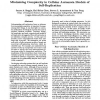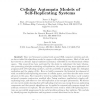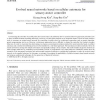139 search results - page 5 / 28 » How Common Can Be Universality for Cellular Automata |
ACRI
2004
Springer
14 years 1 months ago
2004
Springer
Abstract. Genetic Algorithms have been used before to evolve transition rules for one dimensional Cellular Automata (CA) to solve e.g. the majority problem and investigate communic...
IPPS
2000
IEEE
14 years 6 days ago
2000
IEEE
Cellular automata can be used to design high-performance natural solvers on parallel computers. This paper describes the development of applications using CARPET, a high-level prog...
ISMB
1993
13 years 9 months ago
1993
Understanding self-replication from an information processing perspective is important because, amongother things, it can shed light on molecular mechanismsof biological reproduct...
AC
1998
Springer
13 years 7 months ago
1998
Springer
Abstract: Since von Neumann's seminal work around 1950, computer scientists and others have studied the algorithms needed to support self-replicating systems. Much of this wor...
IJON
2006
13 years 7 months ago
2006
Constructing the controller of a mobile robot has several issues to be addressed: how to automate behavior generation procedure, how to insert available domain knowledge effective...



